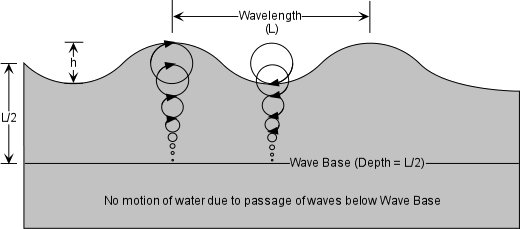WaveSurfer™ system is a wave energy converter that generates electricity by harnessing renewable energy of ocean waves in a manner that is both economically viable and environmentally friendly.
WaveSurfer is a reliable, inexpensive and efficient off-shore system, that can be installed on different depths by mooring. The system contains no expensive or complex parts, lubricants, high precision hydraulics or air pumps, everything that makes other systems more expensive, vulnerable to destructive forces of nature and potentially hazardous.
WaveSurfer technology utilizes finite depth of ocean waves and drag force of water. Motion of water beneath the surface decreases exponentially with depth. No matter how significant wave action is on water surface, water at a depth of one-half wavelength L/2 (wave base) and below is motionless.
WaveSurfer unit comprises two bodies, (1) moored to seabed buoyant body and (2) suspended from it fully submerged frame with installed rotors and electric generator. The submerged body is held at a depth of around one-half wavelength where the water is motionless.
The buoyant body rises with each wave dragging the attached submerged body upward through the region of motionless water until a wave reaches its crest. As the wave falls, the gravity drags the said submerged body downward through the same region of motionless water until the wave reaches its trough.
This up and down motion through a region of stationary water causes rotation of the rotors due to water resistance force (drag force). Rotor buckets are so shaped to move through water with minimum resistance in one direction (drag coefficient CD – 0.09) and with maximum resistance in the opposite direction (drag coefficient CD– 2.0).
Rotation is transmitted to an electric generator installed on the submerged body. The generator is equipped with a flywheel and overrunning clutch to maintain constant rotation.The technology utilizes the water resistance (drag) that opposes the relative motion of the submerged platform with installed rotors through the water. Drag forces act in a direction opposite to the oncoming flow velocity.
For over ten years WaveSurfer projects underwent an extensive environmental assessment with the assistance from The Marine Hydrophysical Institute of the Academy of Sciences of Ukraine. The study featured evaluation of potential impacts on: the seabed, fish and benthic organisms, mammals, vegetation, and water quality. The project study resulted in a finding of no significant impact (FONSI), which is the highest such environmental rating.
The project team considered the following environmental issues:
Modular Ocean Observatory with Unmanned Vehicle recharging capability is powered by the WaveSurfer wave energy conversion technology.
WaveSurfer Modular Ocean Observatory is a floating on the surface modular equipment platform and a below-the-surface modular wave energy converter.
WaveSurfer system is wave direction neutral and operates across a variety of wave heights and periods.
Ocean Observatory's modular design of both platforms, above-the-surface float with installed equipment and below-the-surface power generating wave converter, allows practically unlimited use in scientific research, meteorological, ocean-monitoring and defense applications.
